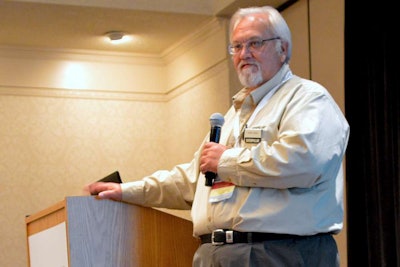 Green
GreenThe first telematics session at the Association of Equipment Management Professionals 33rd Management Conference and Annual Meeting started out with a dire warning about disruptive technology.
Presenter Gerald Green, Caterpillar strategic development manager, asked the heavy equipment fleet managers in the standing-room-only audience, if any of them knew what happened to the Kodak company.
Kodak, he explained, was the first company to develop a digital camera but shelved the project fearing it would cut into sales of their lucrative film and processing business. Of course, dozens of other companies soon developed digital cameras and within a few decades had put the once giant Kodak out of business.
That, says Green, is disruptive technology, and so is heavy equipment telematics.
But by the same token digital imaging sensors offer a vast improvement over film, digital telematics technology also promises to revolutionize the heavy equipment industry, especially in regards to maintenance and mitigating risk, he says.
“If you don’t embrace technology, you are going to join the ranks of these companies that went out of business,” Green says. Look at new cars today, he says. Many can park themselves or tell you when you swerve into another lane. Kids being born today may never have to drive a car, he says, because self driving cars are just around the corner.
And Cat already has an autonomous mining truck that drives itself, Green added. It’s that kind of high-speed, technology-driven change that’s going to fundamentally reshape almost every aspect of heavy equipment operations and maintenance.
If you’re still doing white boards, hand written inspections, leaving a paper trail for everything you do, you’re falling behind competitors who have faster and more efficient electronic and telematics based systems, he says. “The people who are faster and more efficient at leveraging technology in the future are going to get the business,” he says.
The goal is to move everything to a proactive database, Green says. “Don’t let the downtime plan you, you plan the downtime.” You do this with a database populated with information flowing out of your machine’s telematics system.
When you first acquire a piece of new equipment you can create a plan for it in your database, customize the settings, service intervals and other parameters of the scheduled service. With a properly configured database you get alerts on time and never perform a scheduled service too early or too late—or worse yet miss a scheduled service interval entirely, Green says.
Green admits that pulling all this data and technology together can be a nightmare. But the best way to look at this challenge is to see it as an ecosystem. This ecosystem brings data together using a logic that allows you to bring all the related data into one spot. It should also prioritize your information and allow you to initiate action from the alerts. This will require an application program interface or API, to mediate between the machine data and your telematics feed, but an API is not all that difficult to create. It’s basically just HTML computer language he says.
This electronic database-enabled ecosystem serves as a replacement for what Green frequently referred to as “tribal” knowledge, the collective experience and knowledge that’s stored up in the heads of your experienced people. The trouble with tribal knowledge is that it’s sometimes in error or poorly remembered, it requires paper records in many cases, and if the person with the knowledge leaves for just one day, even for a doctor or dentist appointment, that knowledge goes with him or her. If all this knowledge resides on an accessible database, all those problems go away.
Another key to success with telematics says Green to make sure all your systems work on smart phones or tablets. Laptops, he says, are falling out of favor and the ease of use and portability of mobile devices is taking over. Additionally, they don’t require WiFi or internet access to gets updates or information instantly.
Green concluded with a look at the technology that is on the cusp of market acceptance including 3D printers, text to voice, virtual reality goggles that let you fly or walk into or inside a machine and see the entire wiring harness lit up and glow points where ever there might be a fault or short circuit.












